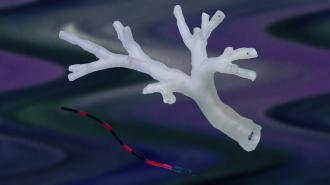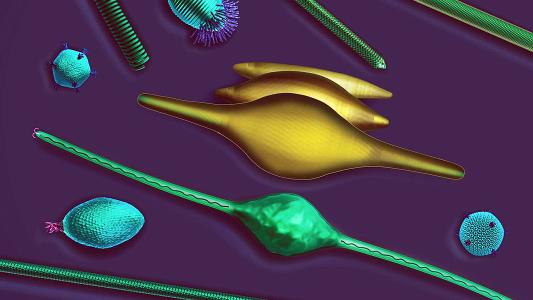Researchers at the University of Leeds in the UK have developed a small, soft, serpentine robot capable of navigating deep into the lungs, where they hope it will be able to take tissues samples and deliver therapies for diseases like lung cancer.
The little wiggler, dubbed a “magnetic tentacle robot,” is made from soft, interconnected cylinders able to be controlled magnetically to slither through the complex, narrow structures of the lung.
“It’s creepy,” lead researcher Pietro Valdastri, chair of robotics and autonomous systems at the University of Leeds, told the Washington Post. “But my goal … is to find a way to reach as deep as possible inside the human body in the least invasive way as possible.”
When doctors want to examine the lungs and air passages, their current tools are limited in how they can be moved, making getting them deep into the delicate structures of the lung difficult.
Navigating the lungs: When doctors want to examine the lungs and air passages, they currently use a device called a bronchoscope. The flexible, tube-shaped device is passed via the nose or mouth into the bronchial tubes that run into the lungs.
But because of its size, the bronchoscope is limited to the upper levels of the bronchial tree, which branches off into smaller and more complex structures — what the researchers deemed a “tortuous and potentially delicate environment” in their study, published in Soft Robotics.
To explore these, doctors need to use a smaller catheter, but the device is limited in how it can be moved, making getting it where it needs to be difficult.
To better navigate the tortuous and delicate maze inside the lungs, the team created a magnetic tentacle robot.
At only 2 millimeters in diameter and with a magnetically controlled shape, the soft robot could “reach most areas of the lung, and would be an important clinical tool in the investigation and treatment of possible lung cancer and other lung diseases,” Valdastri said in a statement.
Building a better bronchial explorer: Two hurdles needed to be cleared for the robot to be effective: it needed to be small and flexible enough to navigate the intricate branches of the bronchial tree, and there needed to be a system to guide it there, a difficult task that necessitates x-rays to see through the body.
To solve the structural challenge, the magnetic tentacle robot was made from a linked series of cylindrical segments of a soft, rubberish compound, “impregnated” with miniscule magnetic particles.
By using an external magnet on these particles, the tiny robot’s segments can be controlled individually, allowing for a wide range of motion. Those external magnets are wielded by robotic arms, which guide the robot to its destination in the lungs autonomously, checking off box number two.
That autonomy may be the robot’s most important ability, according to Johns Hopkins professor of biomedical engineering Nitish V. Thakor.
“I can imagine a future where a full CAT scan is done of the lungs, and the surgeon sits down on a computer and lays out this navigation path of this kind of a snake robot and says: ‘Go get it,’” Thakor told WaPo.
From cadaver to clinic: The researchers predict that their robot is still 5-10 years away from clinical use, due to the typically slow pace of medical device development and authorization. It has successfully navigated a 3D-replica of an anatomically correct bronchial tree, as well as the lungs of cadavers, according to WaPo.
But to be used in living patients, it will also need to adapt its movements to our natural breathing rhythms. And because the guidance system uses magnets, patients with pacemakers or other no-magnets-allowed conditions would not be able to play host to the tentacle bot.
We’d love to hear from you! If you have a comment about this article or if you have a tip for a future Freethink story, please email us at [email protected].






